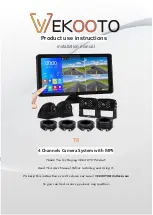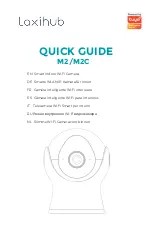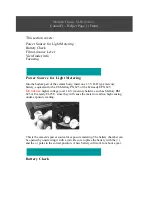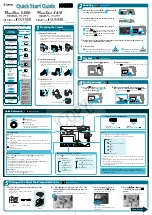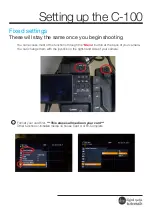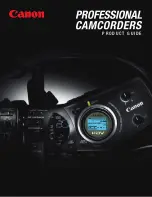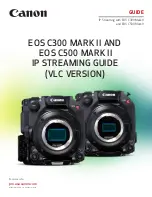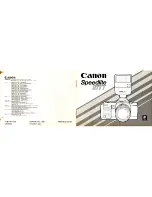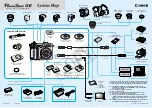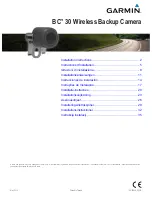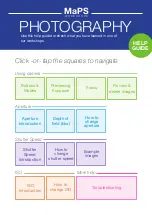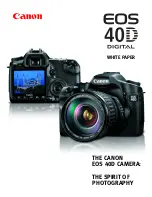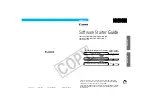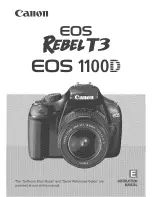
EN
INSTRUCTIONS
Before using your camera, read
these instructions carefully to ensure correct use.
DE
GEBRAUCHSANLEITUNG
Bitte lesen Sie
diese Anleitung vor Gebrauch der Kamera sorgfältig durch,
um eine einwandfreie Handhabung der Kamera zu
gewährleisten.
FR
MODE D’EMPLOI
Avant d’utiliser votre appareil,
veuillez lire attentivement ce mode d’emploi pour garantir
une utilisation correcte.
ES
INSTRUCCIONES
Antes de utilizar su cámara,
lea detenidamente estas instrucciones para asegurarse del
uso correcto.
IT
ISTRUZIONI
Prima di utilizzare la macchina
fotografica, leggere queste istruzioni con attenzione per
essere certi di utilizzarla in modo corretto.
PT
INSTRUÇÕES
Antes de usar sua máquina, leia
estas instruções cuidadosamente para garantir uma
utilização correta.
UA
ІНСТРУКЦІЯ
Перед початком експлуатації
Вашого фотоапарату уважно прочитайте ці інструкції
для гарантування правильного користування.
RU
àHCTPìKñàü èO
ùKCèãìATAñàà
èepeÀ ÌaäaÎoÏ
íÍcÔÎyaÚaáËË BaåeÖo ÙoÚoaÔÔapaÚa ÇÌËÏaÚeÎëÌo
ÔpoäËÚaÈÚe ÀaÌÌêe ËÌcÚpyÍáËË ÀÎÓ oÄecÔeäeÌËÓ
ÔpaÇËÎëÌoÖo ËcÔoÎëÁoÇaÌËÓ.
This device complies with part 15 of the FCC Rules. Operation is
subject to the conditions that this device does not cause harmful
interference.
This Class B digital apparatus meets all requirements of the
Canadian interference-Causing Equipment Regulations.
Cet appareil numérique de la classe B respecte toutes les
exigences du Règlement sur le matériel brouilleur du Canada.
This camera complies with EU directive 89/336/EEC for CE
marking.
Die CE-Marke zeigt an, dass diese Kamera die EG-Richtlinie
89/336EWG erfüllt.
Cet appareil photo est conforme à la directive UE89/336/
CEE pour le marquage CE.
Esta cámara cumple con la directiva de la Unión
Europea 89/336/EEC para la marca de CE.
Questa fotocamera è in conformità alla Direttiva UE 89/
336/CEE per il marchio CE.
Esta máauina segue a directiva da UE 89/336/EEC em
relação a marca “CE”.
Цей фотоапарат задовольняє директиві Європейської
Спiлки 89/336/EEC, що підтверджується знаком
CE
.
ÑaÌÌêÈ ÙoÚoaÔÔapaÚ yÀoÇÎeÚÇopÓeÚ ÀepeÍÚËÇaÏ
EÇpoÔeÈcÍoÖo CoÖïÁa
89/336/EEC
, äÚo
ÔoÀÚÇepÊÀaeÚcÓ ÁÌaÍoÏ
CE
.
• Nous vous conseillons de prendre une pellicule d’essai
avant d’utiliser votre appareil pour prendre
d’importantes photos tel que pendant un voyage à
l’étranger.
AVERTISSEMENT
• Ne jetez pas les piles usées dans le feux et ne les chauffez pas,
ne les démontez pas et n’essayez pas de les court-circuiter.
• En cas d’anomalie ou de panne, retirez
immédiatement les piles mais ne touchez pas l’intérieur
de l’appareil et n’essayez pas de le démonter.
• Ne regardez pas le soleil dans le viseur !
• Se recomienda gastar un rollo de película de prueba
antes de utilizar la cámara para tomar fotografías
importantes, como en un viaje al extranjero, etc.
ADVERTENCIA
• No arroje las pilas usadas al fuego, no las recaliente,
desarme ni las ponga en cortocircuito.
• En caso de anormalidad o rotura, quite
inmediatamente las pilas, pero no toque el interior de
la cámara ni intente desarmarla.
• ¡No mire directamente al sol a través del visor!
• Aconselhamos que experimente tirar um rolo de filmes
antes de usar a máquina para tirar fotos importantes
tais como durante uma viagem, etc.
ADVERTÊNCIA
• Não jogue as pilhas usadas no fogo e não as aqueça,
desmonte ou tente provocar um curto circuito nelas.
• Em caso de anormalidade ou de quebra, retire
imediatamente as pilhas, mas não toque no interior
nem tente desmontar a máquina.
• Não olhe diretamente para o sol através do visor!
• Prima di usare la macchina fotografica per fotografie
importanti quali quelle di una crociera, una luna di
miele, ecc., Olympus consiglia di scattare un rullino di
pellicola di prova.
AVVERTENZA
• Non buttare le pile scariche nel fuoco e non riscaldarle,
smontarle o tentare di ricaricarle.
• In caso di guasto o funzionamento anormale, rimuovere
immediatamente le pile, ma non toccare nulla all’interno,
e non tentare di smontare la macchina fotografica.
• Non puntare il mirino verso il sole e guardare
direttamente al sole attraverso il mirino!
•
îËpÏa Olympus coÇeÚyeÚ BaÏ ÇêÔoÎÌËÚë ÔpoÄÌyï
céeÏÍy Ìa ÔÎeÌÍy ÔepeÀ ËcÔoÎëÁoÇaÌËeÏ BaåeÖo
ÙoÚoaÔÔapaÚa ÀÎÓ cÌÓÚËÓ cepëeÁÌêx ÙoÚocÌËÏÍoÇ,
ÍaÍ ÌaÔpËÏep, ÔyÚeåecÚÇËÓ Áa ÖpaÌËáy, ÏeÀoÇêe
ÏecÓáê Ë Ú.À.
èPEÑìèPEÜÑEHàE
•
He ÇêÄpacêÇaÈÚe ËcÔoÎëÁoÇaÌÌêe ÄaÚapeÈÍË Ç oÖoÌë Ë
Ìe ÔêÚaÈÚecë ÁaÏÍÌyÚë Ëx ÌaÍopoÚÍo.
•
B cÎyäae ÌeÌopÏaÎëÌocÚË ËÎË ÔoÎoÏÍË ÌeÏeÀÎeÌÌo
yÀaÎËÚe ÄaÚapeÈÍË, Ìo Ìe ÚpoÖaÈÚe ÇÌyÚpeÌÌocÚë
ÄaÚapeÈÌoÖo oÚceÍa Ë Ìe ÔêÚaÈÚecë paÁoÄpaÚë
ÙoÚoaÔÔapaÚ.
•
He cÏoÚpËÚe Ìa coÎÌáe äepeÁ ÇËÀoËcÍaÚeÎë!
☆
☆
☆
EN
Names of Parts
Camera body
q
Shutter release button
w
Exposure counter
e
AE light sensor
☆
r
Viewfinder
t
Red-eye reduction lamp
y
Flash
☆
u
Lens
☆
i
Lens barrier switch
o
Strap eyelet
!0
Flash charging indicator
!1
Back cover
!2
Film window
!3
Battery compartment cover
!4
Rewind switch
!5
Tripod socket
!6
Back cover release
☆
Smudges or dirt can cause blurred pictures.
Clean lens by wiping with a soft cloth.
Cautions in regard to batteries
• Observe the caution items listed on the
battery.
• Prepare spare batteries for long trips or
shooting in cold places.
FR
Description des pièces
Boîtier de l’appareil
q
Déclencheur
w
Compteur de vue
e
Capteur de lumière AE
☆
r
Viseur
t
Réduction des yeux rouges
y
Flash
☆
u
Objectif
☆
i
Couvercle d’objectif commutateur
o
Oeillet de courroie
!0
Indicateur de charge du flash
!1
Dos
!2
Fenêtre du film
!3
Couvercle du compartiment à piles
!4
Commutateur de rebobinage
!5
Douille du trépied
!6
Bouton d’ouverture du dos
☆
Les taches et la saleté risquent de rendre
les photos floues. Pour le nettoyer, essuyez-
le avec un chiffon doux.
Précautions relatives aux piles
• Observez les précautions indiquées sur les
piles.
• Lors d’un voyage ou d’une prise de vue
dans un lieu froid, prévoyez des piles de
rechange.
☆
La suciedad o el polvo puede causar fotos
borrosas. Límpie con un paño suave.
Precauciones sobre las pilas
• Por favor observe las precauciones
indicadas para las pilas.
• Lleve una provisión de pilas de repuesto
para los viajes largos o la toma de fotos en
lugares fríos.
ES
Nomenclatura
Cuerpo de la cámara
q
Botón disparador
w
Contador de exposiciones
e
Sensor de luz de AE
☆
r
Visor
t
Reducción de ojos rojos
y
Flash
☆
u
Objetivo
☆
i
Cubreobjetivo interruptor
o
Ojal para la correa
!0
Indicador de carga del flash
!1
Tapa posterior
!2
Ventanilla de la película
!3
Tapa del compartimiento de las pilas
!4
Interruptor de rebobinado
!5
Rosca para el trípode
!6
Desenganche de la tapa posterior
☆
Mantenere il mirino pulito. Sporco o macchie
sarebbero causa di immagini macchiate. Pulire
il mirino strofinandolo con un panno soffice.
Precauzioni riguardo le pile
• Si raccomanda di osservare le
raccomandazioni per la sicurezza
stampate sulle pile.
• Tenere pronte delle pile di riserva prima di
un viaggio lungo, o se si va a scattare
fotografie in posti freddi.
IT
Nomi delle parti
Corpo macchina fotografica
q
Tasto di scatto dell’otturatore
w
Contapose
e
Sensore luce EA
☆
r
Mirino
t
Riduzione occhi rossi
y
Flash
☆
u
Obiettivo
☆
i
Copriobiettivo interruttore
o
Occhiello per la cinghietta
!0
Indicatore dello stato di carica del flash
!1
Coperchio posteriore
!2
Finestrella della pellicola
!3
Coperchio del vano pile
!4
Tasto di riavvolgimento
!5
Attacco del cavalletto
!6
Sgancio del coperchio posteriore
☆
Manchas ou sujeiras podem resultar em fotos
embaçadas. Limpe com um pano macio.
Cuidados em relação às pilhas
• Observe as precauções contidas na pilha.
• Em caso de longas viagens ou quando for
fotografar em locais frios, tenha sempre à
mão pilhas sobressalentes.
PT
Descrição dos componentes
Corpo da máquina
q
Botão do disparador do obturador
w
Contador de exposições
e
Sensor de luz AE
☆
r
Visor
t
Redução de olhos vermelhos
y
Flash
☆
u
Objetiva
☆
i
Vedação da objetiva interruptor
o
Presilha para a alça
!0
Indicação de carregamento do flash
!1
Tampa de trás
!2
Janela do filme
!3
Tampa do compartimento da pilha
!4
Botão de rebobinagem
!5
Encaixe do tripé
!6
Desengate da tampa de trás
èpeÀocÚopoÊÌocÚË oÚÌocËÚeÎëÌo ÄaÚapeeÍ
•
CoÄÎïÀaÈÚe ÔyÌÍÚê ÔpeÀocÚopoÊÌocÚeÈ,
ÔepeäËcÎeÌÌêe Ìa ÄaÚapeÈÍax.
•
èoÀÖoÚaÇÎËÇaÈÚe ÁaÔacÌêe ÄaÚapeÈÍË ÀÎÓ
ÀÎËÚeÎëÌêx ÔoeÁÀoÍ ËÎË ÀÎÓ céeÏoÍ Ç
xoÎoÀÌêx ÏecÚax.
RU
HaÁÇaÌËe äacÚeÈ
KopÔyc ÙoÚoaÔÔapaÚa
q
KÌoÔÍa ocÇoÄoÊÀeÌËÓ ÁaÚÇopa
w
CäeÚäËÍ ÍaÀpoÇ
e
CeÌcop ocÇeçeÌÌocÚË ÔpË
aÇÚoÏaÚËäecÍoÈ íÍcÔoÁËáËË
☆
r
BËÀoËcÍaÚeÎë
t
ìÏeÌëåeÌËe íÙÙeÍÚa ÍpacÌêx ÖÎaÁ
y
BcÔêåÍa
☆
u
OÄéeÍÚËÇ
☆
i
ÂaçËÚÌaÓ ÍpêåÍa oÄéeÍÚËÇa
ÔepeÍÎïäaÚeÎë
o
ìåÍo ÀÎÓ peÏÌÓ
!0
àÌÀËÍaÚop ÁapÓÀÍË ÇcÔêåÍË
!1
ÂaÀÌÓÓ ÍpêåÍa
!2
OÍoåÍo ÔÎeÌÍË
!3
KpêåÍa ÄaÚapeÈÌoÖo oÚceÍa
!4
èepeÍÎïäaÚeÎë ÔepeÏoÚÍË
!5
ÉÌeÁÀo ÀÎÓ ÚpeÌoÖË
!6
OcÇoÄoÊÀeÌËe ÁaÀÌeÈ ÍpêåÍË
☆
CoxpaÌÓÈÚe ÇËÀoËcÍaÚeÎë äËcÚêÏ. ÉpÓÁë ËÎË
ÔêÎë ÏoÖyÚ ÇêÁÇaÚë paÁÏêÚocÚë ËÁoÄpaÊeÌËÈ
OPEN
2.
1.
1.
2.
3.
5.
4.
EN
Inserting the Batteries
1.
Open the battery compartment cover.
2.
Insert the batteries, making sure that they are positioned
correctly. (Use two AA (LR6) alkaline batteries.)
Notes:
• Close the lens barrier before inserting the battery.
• Ni-Cd batteries, manganese batteries, and nickel-hydrogen
batteries cannot be used.
• When the camera is not to be used for an extended period,
remove the batteries to prevent damage due to possible
battery leakage.
• Do not mix different types of batteries, or new and old
batteries.
FR
Mise en place des piles
1.
Ouvrir le compartiment à piles.
2.
Insérez les piles en vous assurant qu’elles sont positionnées
correctement. (Utilisez deux piles alcalines AA (LR6).)
Remarques:
• Refermez le volet de l’objectif avant d’insérer la pile.
• Il n’est pas possible d’utiliser des piles Ni-Cd, des piles au
manganèse ni des piles à l’hydrure de nickel.
• Quand l’appareil ne doit pas être utilisé pendant une période
prolongée, retirez les piles pour éviter tout dommage causé par
une éventuelle fuite d’électrolyte.
• Ne mélangez pas différents types de piles ou une pile neuve
avec une pile usée.
ES
Colocación de las pilas
1.
Abra la tapa del compartimiento de las pilas.
2.
Inserte las pilas, cerciorándose que hayan quedado
correctamente colocadas. (Utilice dos pilas alcalinas AA (LR6)).
Notas:
• Cierre el cubreobjetivo antes de insertar la pila.
• No se pueden usar pilas de Ni-Cd, pilas de manganeso ni
pilas de níquel hidrógeno.
• Para evitar los daños que podría causar el electrólito de las
pilas, cuando no vaya a utilizar la cámara durante mucho
tiempo, extráigale las pilas.
• No mezcle pilas de diferentes tipos, ni una nueva con otra vieja.
PT
Colocação das pilhas
1.
Abra a tampa do compartimento da pilha.
2.
Coloque as pilhas, se certificando que elas estão na
posição correta. (Use duas pilhas alcalinas AA (LR6).)
Notas:
• Feche a tampa da objetiva antes de inserir a bateria.
• Não se podem usar baterias Ni-Cad, de manganês e de
níquel-hidrogênio.
• Retire as pilhas se você não pretende usar a máquina por
um longo período, para que não haja danos provocados
por um possível vazamento das mesmas.
• Não misture tipos diferentes de pilhas nem coloque pilhas
novas junto com velhas.
IT
Inserimento delle pile
1.
Aprire il coperchietto del comparto delle pile.
2.
Inserire le pile assicurandosi che siano posizionate
correttamente. (Usare due pile alcaline di formato AA (LR6).)
Note:
• Chiudere il copriobbiettivo prima di procedere con l’inserimento
della batteria.
• Non devono essere utilizzate batterie di tipo Ni-Cd, manganese
o nichel-idrogeno.
• Quando la macchina fotografica non viene usata per un lungo
periodo, rimuovere le pile per evitare che una possibile
fuoriuscita di liquido possa causare danni.
• Non usare tipi di pile differenti o pile nuove e usate
contemporaneamente.
RU
BcÚaÇÍa ÄaÚapeeÍ
1.
OÚÍpoÈÚe ÍpêåÍy ÄaÚapeÈÌoÖo oÚceÍa.
2.
BcÚaÇëÚe ÄaÚapeÈÍË, ÔoÀÚÇepÀËÇ ÔpaÇËÎëÌocÚë
ÔoÎÓpÌocÚË. (àcÔoÎëÁyÈÚe ÀÇe çeÎoäÌêe ÄaÚapeÈÍË AA
(LR6))
èpËÏeäaÌËÓ:
•
ÂaÍpoÈÚe oÖpaÌËäËÚeÎë oÄéeÍÚËÇa ÔepeÀ ycÚaÌoÇÍoÈ ÄaÚapeË.
•
HËÍeÎë-ÍaÀÏËeÇêe ÄaÚapeÈÍË, ÏapÖaÌáeÇêe ÄaÚapeÈÍË Ë
ÌËÍeÎë-ÖËÀpËÀÌêe ÄaÚapeÈÍË Ìe ÏoÖyÚ ÄêÚë ËcÔoÎëÁoÇaÌê.
•
KoÖÀa ÙoÚoaÔÔapaÚ Ìe ÄyÀeÚ ËcÔoÎëÁoÇaÚëcÓ ÀÎËÚeÎëÌêÈ
ÔepËoÀ ÇpeÏeÌË, ÇêÌëÚe ÄaÚapeÈÍË ÀÎÓ ÔpeÀoÚÇpaçeÌËÓ
ÇoÁÏoÊÌoÖo ÔoÇpeÊÀeÌËÓ ËÁ-Áa ÔpoÚeäÍË ÄaÚapeeÍ.
•
He cÏeåËÇaÈÚe paÁÎËäÌêe ÚËÔê ÄaÚapeeÍ ËÎË ÌoÇêe Ë
cÚapêe ÄaÚapeÈÍË.
EN
Checking the batteries
1.
Slide the lens barrier switch to turn the camera on. (
q
)
2.
Confirm that the flash charging indicator is lit (
z
).
• The flash charging indicator goes out automatically
after about 4 minutes of non usage.
Note:
• Please replace the battery when it takes 15 sec or
longer for the flash indicator to light up.
ES
Verificación de las pilas
1.
Gire el interruptor del cubreobjetivo para encender la
cámara. (
q
)
2.
Confirme que el indicador de carga del flash esté
iluminado. (
z
).
• El indicador de carga del flash se apaga
automáticamente después de aproximadamente 4
minutos.
Notas:
• Por favor cambie la pila cuando el indicador de carga
del flash tarde 15 segundos o más en cargarse.
PT
Verificação das baterias
1.
Aperte o interruptor da tampa da objetiva para ligar
a máquina fotográfica.(
q
)
2.
Verifique se o indicador de recarregamento do flash
está aceso. (
z
)
• O indicador de recarga do flash se desliga
automaticamente depois de cerca de 4 minutos.
Notas:
• Troque a bateria quando levar 15 segundos ou mais
para acender o indicador de carregamento do flash.
IT
Controllo della batteria
1.
Aprire il copriobiettivo per accendere la fotocamera.
(
q
)
2.
Verificare che l’indicatore di carica flash sia acceso.
(
z
).
• L’indicatore di carica flash si spegne
automaticamente dopo circa 4 minuti.
Note:
• Sostituire la batteria quando la spia di flash pronto
richiede più di 15 secondi ad accendersi.
RU
èpoÇepÍa ÄaÚapeÈ
1.
èoÇepÌËÚe ÔepeÍÎïäaÚeÎë oÖpaÌËäËÚeÎÓ
oÄéeÍÚËÇa ÀÎÓ ÇÍÎïäeÌËÓ ÙoÚoaÔÔapaÚa. (
q
)
2.
ìÄeÀËÚecë, äÚo ËÌÀËÍaÚop ÁapÓÀÍË ÇcÔêåÍË
ÇêcÇeäËÇaeÚcÓ. (
z
)
•
ï àÌÀËÍaÚop ÁapÓÀÍË ÇcÔêåÍË aÇÚoÏaÚËäecÍË
ÔoÖacÌeÚ cÔycÚÓ ÔpËÏepÌo 4 ÏËÌyÚ.
èpËÏeäaÌËÓ:
•
èoÊaÎyÈcÚa, ÁaÏeÌËÚe ÄaÚapeÈÍy, ecÎË ËÌÀËÍaÚop
ÁapÓÀa ÇcÔêåÍË ÇêcÇeäËÇaeÚcÓ ÔoÁÊe, äeÏ äepeÁ 15 ceÍ.
EN
Loading the Film
1.
Open the back cover by sliding the back cover
release in upward direction (
q
).
2.
Insert the film and make sure the film leader is lying
flat.
Notes:
• Use negative color film with ISO 100, 200 or 400 DX
coding.
•
Align the film leader with the mark, position the film
so it does not overlap any of the positioning guides
A
.
3.
Close the back cover.
4.
Slide the lens barrier switch to turn the camera on. (
w
)
5.
Press the shutter release button and confirm advance
of the exposure counter.
Press the shutter release button until the exposure
counter reads “1.”
Note: If the exposure counter does not advance, the film
was not loaded correctly, open the back cover and
reinsert the film.
FR
Chargement du film
1.
Ouvrez le dos en faisant glisser le bouton d’ouverture
du dos vers le haut (
q
).
2.
Insérez la cartouche du film en vous assurant que
l’amorce du film est bien plate.
Remarques:
• Utilisez un film couleur négatif 100, 200 ou 400 ISO avec
codage DX.
•
Alignez l’amorce du film avec la marque et
positionnez le film de façon à ce qu’il ne recouvre
aucun des guides de positionnement
A
.
3.
Refermez le dos.
4.
Tournez le commutateur du volet de l’objectif (
w
)
pour mettre l’appareil sous tension.
5.
Appuyez sur le déclencheur et vérifiez que le film a
avancé sur le compteur de vue.
Appuyez sur le déclencheur jusqu’à ce que le
compteur de vue indique “1”.
Remarque: Si le compteur de vue n’avance pas, ouvrez le
dos et réinsérez le film.
ES
Carga de la película
1.
Abra la cubierta trasera deslizando el desenganche
de la cubierta trasera hacia arriba (
q
).
2.
Inserte el carrete de película y asegúrese de que la
película guía quede tensada.
Notas:
• Utilice una película de color negativa con codificación
DX de ISO 100, 200 o 400.
•
Alineando la guía de la película con la marca,
posicione la película de manera que no se superponga
con ninguna de las guías de posicionamiento
A
.
3.
Cierre la tapa posterior.
4.
Gire el interruptor del cubreobjetivo (
w
) para
encender la cámara.
5.
Oprima el botón disparador y confirme el avance del
contador de exposiciones.
Oprima el disparador hasta que aparezca “1” en el
contador de exposiciones.
Nota: Si el contador de exposiciones no avanza, abra la
tapa posterior y reinserte la película.
PT
Colocação do filme
1.
Abra a tampa de trás deslizando para cima seu
desengate (
q
).
2.
Coloque o rolo do filme, de maneira que a guia do
filme fique plana.
Notas:
• Use o filme negativo colorido de código DX, de ISO
100, 200 ou 400.
•
Alinhe a guia do filme na marca, posicione o filme de
maneira que ele não se sobreponha a nenhuma
guia
A
.
3.
Feche a tampa posterior.
4.
Ligue o interruptor da tampa da objetiva (
w
) para
ligar a máquina fotográfica.
5.
Aperte o botão do disparador do obturador e
confirme o avanço do contador de exposições.
Aperte o botão de disparador do obturador até que
o contador de exposição chegue ao número 1.
Nota: Se o contador de exposições não avançar, abra a
tampa de trás e recoloque o filme na posição correta.
RU
ÂaÖpyÁÍa ÔÎeÌÍË
1.
OÚÍpoÈÚe ÁaÀÌïï ÍpêåÍy, ÔepeÀÇËÌyÇ ÁaçeÎÍy
ÁaÀÌeÈ ÍpêåÍË ÇÇepx (
q
).
2.
BcÚaÇëÚe ÔÎeÌÍy Ë yÄeÀËÚecë, äÚo ÔepeÀÌËÈ
ÍoÌeá ÔÎeÌÍË pacÔoÎoÊeÌ poÇÌo.
èpËÏeäaÌËÓ:
•
àcÔoÎëÁyÈÚe ÌeÖaÚËÇÌyï áÇeÚÌyï ox-ÍoÀoÇyï
ÔÎeÌÍy ISO 100, 200 ËÎË 400.
•
CoÇÏecÚËÚe paÍopÀ ÔÎeÌÍË c ÏeÚÍoÈ,
pacÔoÎoÊËÇ ÔÎeÌÍy ÚaÍ, äÚoÄê oÌa Ìe
ÔepeÍpêÇaÎa ÌËÍaÍËe ÔoÁËáËË ÌaÔpaÇÎÓïçËx
A
.
3.
ÂaÍpoÈÚe ÁaÀÌïï ÍpêåÍy.
4.
èoÇepÌËÚe ÔepeÍÎïäaÚeÎë oÖpaÌËäËÚeÎÓ
oÄéeÍÚËÇa (
w
) ÀÎÓ ÇÍÎïäeÌËÓ ÙoÚoaÔÔapaÚa.
5.
HaÊÏËÚe ÍÌoÔÍy ocÇoÄoÊÀeÌËÓ ÁaÚÇopa Ë
yÄeÀËÚecë, äÚo Bê yÇËÀeÎË paÏÍy ÙoÍycËpoÇÍË.
HaÊÏËÚe ÍÌoÔÍy ocÇoÄoÊÀeÌËÓ ÁaÚÇopa ÚaÍ,
äÚoÄê paÏÍa ÙoÍycËpoÇÍË ycÚaÌoÇËÎacë Ìa “1”.
èpËÏeäaÌËe: EcÎË paÏÍa ÙoÍycËpoÇÍË Ìe
ÔoÓÇÎÓeÚcÓ, oÚÍpoÈÚe ÁaÀÌïï ÍpêåÍy Ë
ÔepeÁapÓÀËÚe ÔÎeÌÍy.
FR
Vérification des piles
1.
Tournez le commutateur du volet de l’objectif pour
mettre l’appareil sous tension. (
q
)
2.
Vérifiez que l’indicateur de recharge du flash est
allumé. (
z
)
• L’indicateur de recharge du flash s’éteint
automatiquement au bout de 4 minutes environ.
Remarques:
• Remplacez la batterie lorsqu’il faut 15 secondes ou plus
pour que l’indicateur de recharge du flash s’allume.
• Olympus advises you to shoot a trial roll of film before
using your camera to take important photographs
such as on an overseas trip, honeymoons, etc.
WARNING
• Do not put the used batteries into a fire and do not
heat, disassemble or try to short them out.
• In case of abnormality or breakage, immediately
remove the batteries, but do not touch the inside and
do not try to disassemble the camera.
• Do not look into the sun through the viewfinder!
•
Фірма Olympus радить Вам виконати пробну зйомку на
плівку перед використанням Вашого фотоапарату для
зйомок важливих фотознімків, як наприклад, подорож
за кордон, медові місяці і т.д.
ПОПЕРЕДЖЕННЯ
•
Не кладіть використані батарейки у вогонь, не
нагрівайте, не розбирайте їх і не намагайтесь їх
коротко замкнути.
•
У випадку ненормальної роботи або поломки негайно
вийміть батарейки, але не доторкайтесь до
внутрішньої сторони батарейного відсіку і не
намагайтесь розібрати фотоапарат.
•
Не дивіться на сонце через видошукач!
UA
Назви частин
Корпус фотоапарату
q
Кнопка звільнення затвору
w
Лічильник кадрів
e
Сенсор освітлюваності при автоматичній
експозиції
☆
r
Видошукач
t
Лампочка зменшення ефекту червоних
очей
y
Спалах
☆
u
Об’єктив
☆
i
Перемикач захисної кришки об’єктиву
o
Вушко для ременя
!0
Індикатор зарядки спалаху
!1
Задня кришка
!2
Віконце плівки
!3
Кришка батарейного відсіку
!4
Перемикач перемотування
!5
Гніздо для штативу
!6
Клямка задньої кришки
☆
Плями або бруд можуть спричинити
розмитість зображення. Очищуйте їх за
допомогою протирання м’якою тканиною.
Застереження відносно батарейок
•
Дотримуйтесь пунктів застережень,
перерахованих на батарейці.
•
Підготуйте запасні батарейки для довгих
подорожей або для зйомок в холодних
місцях.
UA
Вставка батарейок
1.
Відкрийте кришку батарейного відсіку.
2.
Вставте батарейки, перевіривши вірність їхнього
розташування. (Використовуйте дві лужні батарейки AA
(LR6)).
Примітки:
•
Закрийте захисну кришку об’єктиву перед вставкою
батарейки.
•
Нікель-кадмiйовi батарейки, марганцеві батарейки і нікель-
гiдриднi батарейки не можуть бути використані.
•
Якщо фотоапарат не буде використовуватись на протязі
довгого періоду часу, вийміть батарейки для відвернення
можливого пошкодження внаслідок протікання батарейок.
•
Не змішуйте різні типи батарейок або нові та старі батарейки.
UA
Перевірка батарейок
1.
Поверніть перемикач захисної кришки об’єктиву
для вмикання фотоапарату. (
q
)
2.
Переконайтесь, що індикатор зарядки спалаху
висвітлюється. (
z
)
•
Індикатор зарядки спалаху автоматично згасне
приблизно через 4 хвилин.
Примітка:
•
Будь ласка, замініть батарейку, якщо індикатор
заряду спалаху висвічується пізніше, ніж через 15
сек.
UA
Заряджання плівки
1.
Відкрийте задню кришку, пересунувши клямку
задньої кришки вгору (
q
).
2.
Вставте плівку і переконайтесь, що передній
кінець плівки розташований рівно.
Примітки:
•
Використовуйте негативну кольорову DX-кодову
плівку ISO 100, 200 або 400.
•
Сполучіть передній кінець плівки з позначкою,
розташувавши плівку таким чином, щоб вона не
перекривала жодної з позиційних напрямних
A
.
3.
Закрийте задню кришку.
4.
Поверніть перемикач захисної кришки об’єктиву
(
w
) для вмикання фотоапарату.
5.
Натисніть кнопку звільнення затвору і
переконайтесь в просуванні вперед лічильника
кадрів.
Натискуйте кнопку звільнення затвору до тих пір,
доки лічильник кадрів не покаже “1”.
Примітка: Якщо лічильник кадрів не просувається
вперед, відкрийте задню кришку і перезарядіть
плівку.
• Es ist ratsam, einen Film mit Probeaufnahmen zu
machen, bevor die Kamera für wichtige Aufnahmen
wie z. B. auf einer Auslandsreise usw. verwendet wird.
WARNUNG
• Werfen Sie keine Batterien ins Feuer. Batterien dürfen
auch nicht erhitzt, zerlegt oder kurzgeschlossen werden.
• Im Fall einer Störung oder bei Bruch sofort die Batterien
entfernen, aber nicht das Innere berühren und nicht
versuchen, die Kamera zu zerlegen.
• Nicht durch den Sucher in die Sonne sehen!
DE
Beschreibung der
Bedienungselemente
Kameragehäuse
q
Auslöser
w
Bildzählwerk
e
Belichtungsmesser
☆
r
Sucher
t
Anzeige Reduzierung des „Rote-Augen-
Effekts“
y
Blitz
☆
u
Objektiv
☆
i
Objektivschutzschieber Schalter
☆
Durch Verschmutzung kann es zu
unscharfen Bildern kommen. Mit einem
Tuch sauberwischen.
Batteriehinweise
• Bitte die auf der Batterie aufgedruckten
Hinweise beachten.
• Für längere Reisen oder Fotografieren an
kalten Orten bitte Reservebatterien
mitführen.
o
Ose für Trageriemen
!0
Blitzbereitschaftsanzeige
!1
Rückwand
!2
Filmfenster
!3
Batteriefachdeckel
!4
Rückspulschalter
!5
Stativgewinde
!6
Rückwandentriegelung
DE
Batterien einlegen
1.
Öffnen Sie den Batteriefachdeckel.
2.
Legen Sie die Batterien mit der korrekten Polarität ein.
(Verwenden Sie zwei AA [LR6] Alkalibatterien.)
Hinweise:
• Schließen Sie den Objektivdeckel vor dem Einlegen der Batterie.
• Nickel-Kadmium-Batterien, Mangan-Batterien und Nickel-
Wasserstoff-Batterien können nicht verwendet werden.
• Wenn die Kamera längere Zeit nicht genutzt wird, so entfernen
Sie die Batterien, um Schäden durch Auslaufen der Batterien zu
vermeiden.
• Bitte verwenden Sie keine Batterien unterschiedlicher Hersteller
bzw. gebrauchte und neue Batterien zusammen.
DE
Überprüfen der Batterien
1.
Drehen Sie den Schalter für den Objektivdeckel, um
die Kamera einzuschalten. (
q
)
2.
Vergewissern Sie sich, dass die Blitzladeanzeige
leuchtet. (
z
).
• Die Blitzladeanzeige geht nach etwa 4 Minuten
automatisch aus.
Hinweise:
• Bitte wechseln Sie die Batterie aus, wenn es 15 Sekunden
oder länger dauert, bis die Blitzladeanzeige aufleuchtet.
3.
Schließen Sie die Rückwand.
4.
Drehen Sie den Schalter für den Objektivdeckel (
w
),
um die Kamera einzuschalten.
5.
Drücken Sie den Auslöser mehrmals hintereinander,
bis das Bildzählwerk „1“ anzeigt.
Hinweis: Wenn das Bildzählwerk keinen Filmtransport
anzeigt, so öffnen Sie die Rückwand und legen Sie den
Film erneut ein.
DE
Einlegen des Films
1.
Öffnen Sie die Rückwand, indem Sie die
Rückwandentriegelung nach oben schieben (
q
).
2.
Legen Sie die Filmpatrone ein und achten Sie darauf,
dass die Filmtransportzunge flach liegt.
Hinweise:
• Verwenden Sie einen mit DX kodierten Negativfarbfilm
der Empfindlichkeit ISO 100, 200 oder 400.
•
Richten Sie die Filmzunge auf die Markierung aus und
positionieren Sie den Film so, dass er keine der
Positionierungsführungen überdeckt
A
.
IT
Inserimento della Pellicola
1.
Aprire il coperchio posteriore spingendo il tastino di
sgancio del coperchio posteriore all’insù (
q
).
2.
Inserire il caricatore di pellicola e assicurarsi che la
linguetta iniziale della pellicola sia disposta
correttamente.
Note:
• Usare una pellicola negativa a colori di codice DX di 100,
200 o 400 ISO.
•
Allineare l’estremità della linguetta iniziale della pellicola
con il segno, posizionando la pellicola in modo che non
scorra sopra la guida della pellicola
A
.
3.
Chiudere il coperchio posteriore.
4.
Aprire il copriobiettivo (
w
) per accendere la fotocamera.
5.
Premere il tasto di scatto dell’otturatore e controllare che il
contapose avanzi.
Premere il tasto di scatto dell’otturatore fino a che nel
contapose appare æ“1”.
Nota: Se il contapose non avanza, aprire il coperchio
posteriore e reinserire la pellicola.
This symbol [crossed-out wheeled bin WEEE Annex IV] indicates separate
collection of waste electrical and electronic equipment in the EU countries.
Please do not throw the equipment into the domestic refuse.
Please use the return and collection systems available in your country for the
disposal of this product.
Le symbole [poubelle sur roue barrée d’une croix WEEE annexe IV] indique une collecte
séparée des déchets d’équipements électriques et électroniques dans les pays de L’UE.
Veuillez ne pas jeter l’équipement dans les ordures domestiques.
A utiliser pour la mise en rebut de ces types d’équipements conformément aux
systèmes de traitement et de collecte disponibles dans votre pays.
Dieses Symbol [durchgestrichene Mülltonne nach WEEE Anhang IV] weist auf die
getrennte Rücknahme elektrischer und elektronischer Geräte in EU-Ländern hin.
Bitte werfen Sie das Gerät nicht in den Hausmüll. Informieren Sie sich über das in Ihrem
Land gültige Rücknahmesystem und nutzen dieses zur Entsorgung.
Este símbolo [un contenedor de basura tachado con una X en el Anexo IV de WEEE]
indica que la recogida de basura de equipos eléctricos y electrónicos deberá tratarse por
separado en los países de la Unión Europea. No tire este equipo a la basura doméstica.
Para el desecho de este tipo de equipos utilice los sistemas de devolución al vendedor y
de recogida que se encuentren disponibles.
CG850401
Summary of Contents for TRIP 600
Page 2: ......
Page 4: ... ...
Page 6: ...O P E N 2 1 ...
Page 8: ......
Page 10: ...1 2 3 5 4 ...
Page 13: ......
Page 15: ......
Page 17: ......
Page 19: ...1 2 ...


















